engine PORSCHE 911 GT2 2010 5.G Information Manual
[x] Cancel search | Manufacturer: PORSCHE, Model Year: 2010, Model line: 911 GT2, Model: PORSCHE 911 GT2 2010 5.GPages: 35, PDF Size: 3.73 MB
Page 4 of 35
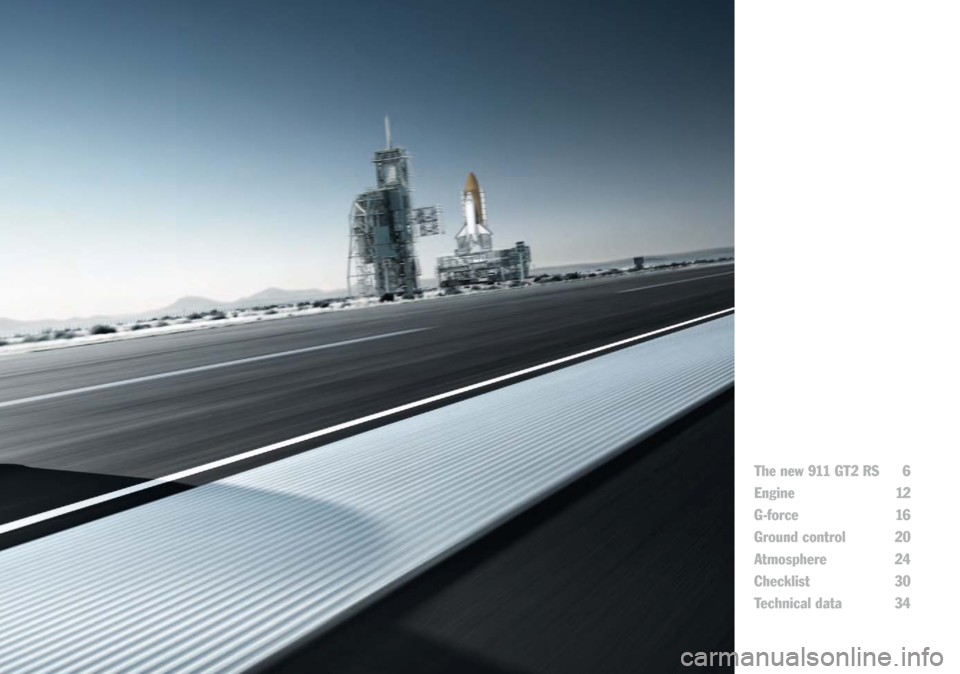
The new 911 GT2 RS 6
Engine 12
G-force 16
Ground control 20
Atmosphere 24
Checklist 30
Technical data 34
Page 6 of 35
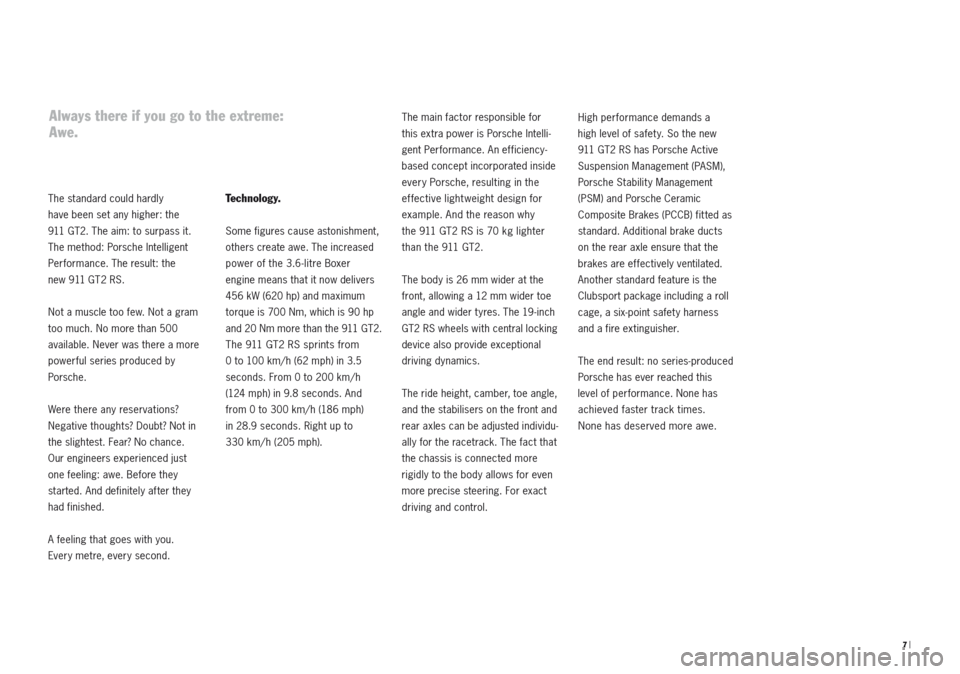
7 |
The standard could hardly
have been set any higher: the
911 GT2. The aim: to surpass it.
The method: Porsche Intelligent
Performance. The result: the
new 911 GT2 RS.
Not a muscle too few. Not a gram
too much. No more than 500
available. Never was there a more
powerful series produced by
Porsche.
Were there any reservations?
Negative thoughts? Doubt? Not in
the slightest. Fear? No chance.
Our engineers experienced just
one feeling: awe. Before they
started. And definitely af ter they
had finished.
A feeling that goes with you.
Every metre, every second.
Te c h n o l o g y.
Some figures cause astonishment,
others create awe. The increased
power of the 3.6-litre Boxer
engine means that it now delivers
456 kW (620 hp) and maximum
torque is 700 Nm, which is 90 hp
and 20 Nm more than the 911 GT2.
The 911 GT2 RS sprints from
0 to 100 km/ h (62 mph) in 3.5
seconds. From 0 to 200 km/ h
(124 mph) in 9.8 seconds. And
from 0 to 300 km/ h (186 mph)
in 28.9 seconds. Right up to
330 km/h
(205 mph).
The main factor responsible for
this extra power is Porsche Intelli-
gent Performance. An efficiency-
based concept incorporated inside
every Porsche, resulting in the
ef fective light weight design for
example. And the reason why
the 911 GT2 RS is 70 kg lighter
than the 911 GT2.
The body is 26 mm wider at the
front, allowing a 12 mm wider toe
angle and wider tyres. The 19-inch
GT2 RS wheels with central locking
device also provide exceptional
driving dynamics.
The ride height, camber, toe angle,
and the stabilisers on the front and
rear axles can be adjusted individu-
ally for the racetrack. The fact that
the chassis is connected more
rigidly to the body allows for even
more precise steering. For exact
driving and control.High performance demands a
high level of safety. So the new
911 GT2 RS has Porsche Active
Suspension Management (PASM),
Porsche Stability Management
(PSM) and Porsche Ceramic
Composite Brakes (PCCB) fitted as
standard. Additional brake ducts
on the rear axle ensure that the
brakes are effectively ventilated.
Another standard feature is the
Clubsport package including a roll
cage, a six-point safety harness
and a fire extinguisher.
The end result: no series-produced
Porsche has ever reached this
level of performance. None has
achieved faster track times.
None has deserved more awe.
Always there if you go to the extreme:
Awe.
Page 7 of 35
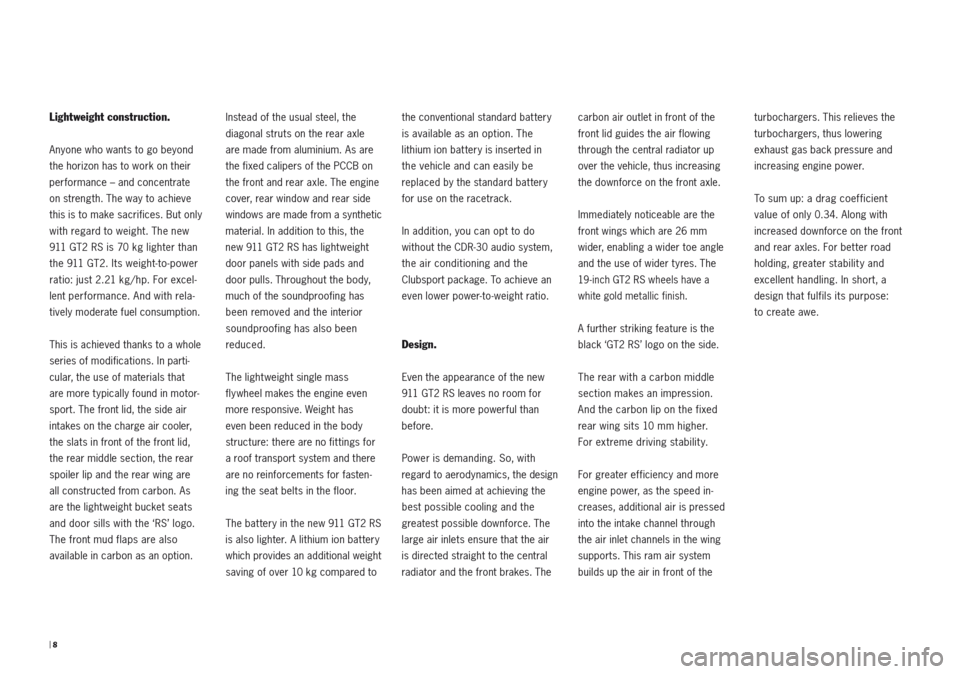
| 8
carbon air outlet in front of the
front lid guides the air flowing
through the central radiator up
over the vehicle, thus increasing
the downforce on the front axle.
Immediately noticeable are the
front wings which are 26 mm
wider, enabling a wider toe angle
and the use of wider tyres. The
19-inch GT2 RS wheels have a
white gold metallic finish.
A further striking feature is the
black ‘GT2 RS’ logo on the side.
The rear with a carbon middle
section makes an impression.
And the carbon lip on the fixed
rear wing sits 10 mm higher.
For extreme driving stability.
For greater efficiency and more
engine power, as the speed in-
creases, additional air is pressed
into the intake channel through
the air inlet channels in the wing
supports. This ram air system
builds up the air in front of the
Lightweight construction.
Anyone who wants to go beyond
the horizon has to work on their
performance – and concentrate
on strength. The way to achieve
this is to make sacrifices. But only
with regard to weight. The new
911 GT2 RS is 70 kg lighter than
the 911 GT2. Its weight-to-power
ratio: just 2.21 kg/ hp. For excel-
lent performance. And with rela-
tively moderate fuel consumption.
This is achieved thanks to a whole
series of modifications. In parti-
cular, the use of materials that
are more typically found in motor-
sport. The front lid, the side air
intakes on the charge air cooler,
the slats in front of the front lid,
the rear middle section, the rear
spoiler lip and the rear wing are
all constructed from carbon. As
are the lightweight bucket seats
and door sills with the ‘RS’ logo.
The front mud flaps are also
available in carbon as an option. Instead of the usual steel, the
diagonal struts on the rear axle
are made from aluminium. As are
the fixed calipers of the PCCB on
the front and rear axle. The engine
cover, rear window and rear side
windows are made from a synthetic
material. In addition to this, the
new 911 GT2 RS has light weight
door panels with side pads and
door pulls. Throughout the body,
much of the soundproofing has
been removed and the interior
soundproofing has also been
reduced.
The lightweight single mass
fly wheel makes the engine even
more responsive. Weight has
even been reduced in the body
structure: there are no fittings for
a roof transport system and there
are no reinforcements for fasten-
ing the seat belts in the floor.
The battery in the new 911 GT2 RS
is also lighter. A lithium ion battery
which provides an additional weight
saving of over 10 kg compared to the conventional standard battery
is available as an option. The
lithium ion battery is inserted in
the vehicle and can easily be
replaced by the standard battery
for use on the racetrack.
In addition, you can opt to do
without the CDR-30 audio system,
the air conditioning and the
Clubsport package. To achieve an
even lower power-to-weight ratio.
Design.
Even the appearance of the new
911 GT2 RS leaves no room for
doubt: it is more powerful than
before.
Power is demanding. So, with
regard to aerodynamics, the design
has been aimed at achieving the
best possible cooling and the
greatest possible downforce. The
large air inlets ensure that the air
is directed straight to the central
radiator and the front brakes. The turbochargers. This relieves the
turbochargers, thus lowering
exhaust gas back pressure and
increasing engine power.
To sum up: a drag coefficient
value of only
0.34. Along with
increased downforce on the front
and rear axles. For better road
holding, greater stabilit y and
excellent handling. In short, a
design that fulfils its purpose:
to create awe.
Page 9 of 35
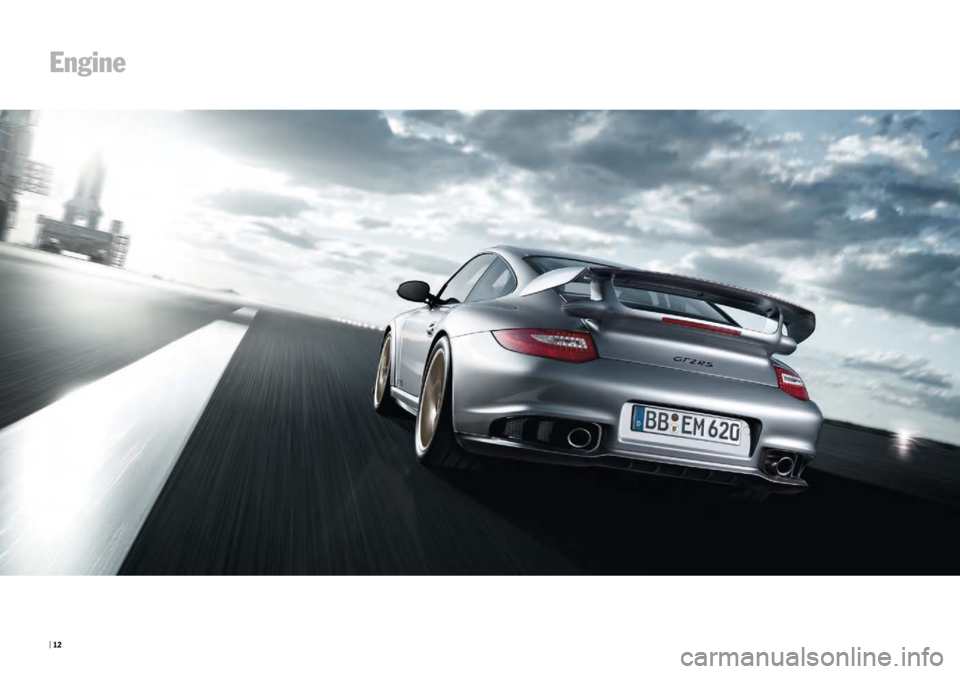
| 12
Engine
Page 10 of 35
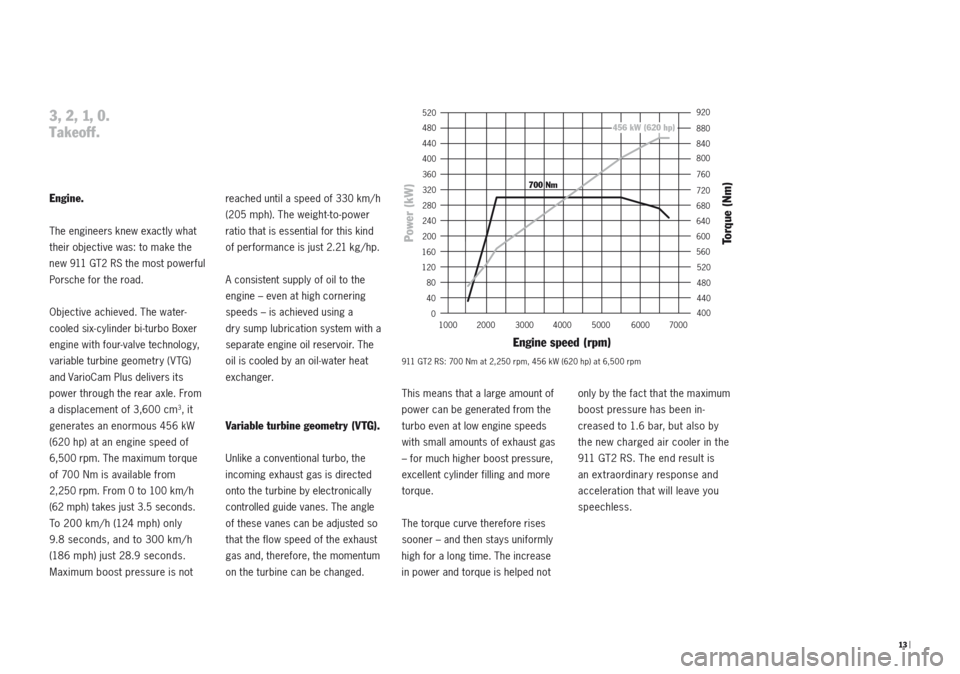
13 |
Engine.
The engineers knew exactly what
their objective was: to make the
new 911 GT2 RS the most powerful
Porsche for the road.
Objective achieved. The water-
cooled six- cylinder bi-turbo Boxer
engine with four-valve technology,
variable turbine geometry (VTG)
and VarioCam Plus delivers its
power through the rear axle. From
a displacement of 3,600 cm3, i t
generates an enormous 456 kW
(620 hp) at an engine speed of
6,500 rpm. The maximum torque
of 700 Nm is available from
2,250 rpm. From 0 to 100 km/ h
(62 mph) takes just 3.5 seconds.
To 200 km/ h (124 mph) only
9.8 seconds, and to 300 km/ h
(186 mph) just 28.9 seconds.
Maximum boost pressure is
not reached until a speed of 330 km/ h
(205 mph). The weight-to-power
ratio that is essential for this kind
of performance is just 2.21 kg/ hp.
A consistent supply of oil to the
engine – even at high cornering
speeds – is achieved using a
dry sump lubrication system with a
separate engine oil reservoir. The
oil is cooled by an oil-water heat
exchanger.
Variable turbine geometry (VTG).
Unlike a conventional turbo, the
incoming exhaust gas is directed
onto the turbine by electronically
controlled guide vanes. The angle
of these vanes can be adjusted so
that the flow speed of the exhaust
gas and, therefore, the momentum
on the turbine can be changed. This means that a large amount of
power can be generated from the
turbo even at low engine speeds
with small amounts of exhaust gas
– for much higher boost pressure,
excellent cylinder filling and more
torque.
The torque curve therefore rises
sooner – and then stays uniformly
high for a long time. The increase
in power and torque is helped not
3, 2, 1, 0.
Takeoff.
only by the fact that the maximum
boost pressure has been in-
creased to 1.6 bar, but also by
the new charged air cooler in the
911 GT2 RS. The end result is
an extraordinary response and
acceleration that will leave you
speechless.
911 GT2 RS: 700 Nm at 2,250 rpm, 456 kW (620 hp) at 6,500 rpm
400 560 600 640
680 720 760 800 840 880 920
200 240
280 320 360 400 440 480 520
2000 3000 4000 5000 6000 7000440 480 5201000
Power (kW)
Engine speed (rpm)
0 40 80 120 160
Torque (Nm)
700 Nm
456 kW (620 hp)
Page 11 of 35
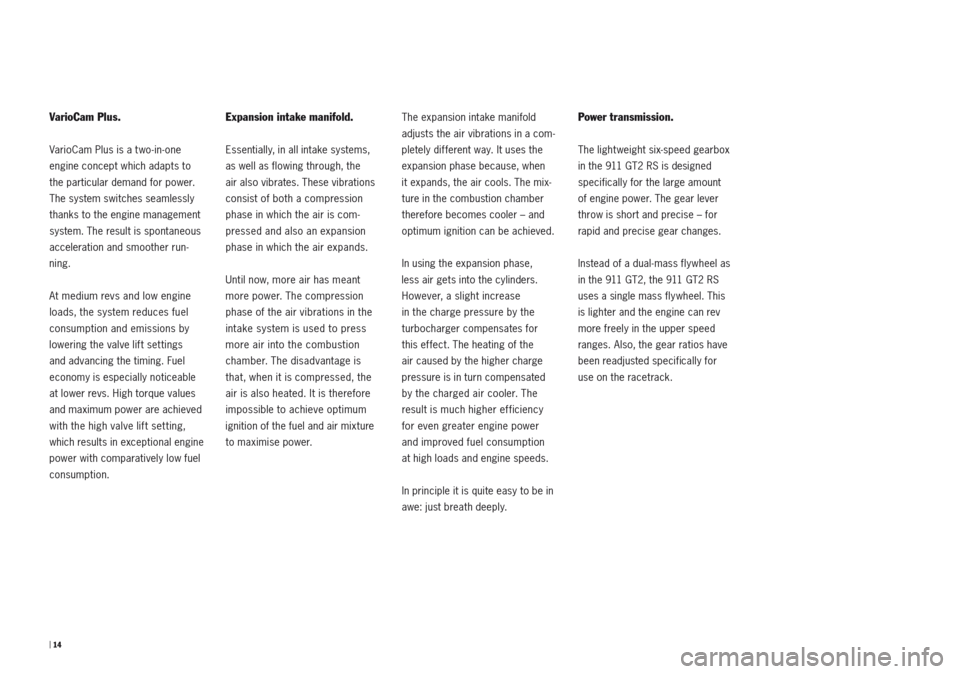
| 14
VarioCam Plus.
VarioCam Plus is a two-in-one
engine concept which adapts to
the particular demand for power.
The system switches seamlessly
thanks to the engine management
system. The result is spontaneous
acceleration and smoother run-
ning.
At medium revs and low engine
loads, the system reduces fuel
consumption and emissions by
lowering the valve lift settings
and advancing the timing. Fuel
economy is especially noticeable
at lower revs. High torque values
and maximum power are achieved
with the high valve lift setting,
which results in exceptional engine
power with comparatively low fuel
consumption.
Expansion intake manifold.
Essentially, in all intake systems,
as well as flowing through, the
air also vibrates. These vibrations
consist of both a compression
phase in which the air is com-
pressed and also an expansion
phase in which the air expands.
Until now, more air has meant
more power. The compression
phase of the air vibrations in the
intake system is used to press
more air into the combustion
chamber. The disadvantage is
that, when it is compressed, the
air is also heated. It is therefore
impossible to achieve optimum
ignition of the fuel and air mixture
to maximise power.The expansion intake manifold
adjusts the air vibrations in a com-
pletely different way. It uses the
expansion phase because, when
it expands, the air cools. The mix-
ture in the combustion chamber
therefore becomes cooler – and
optimum ignition can be achieved.
In using the expansion phase,
less air gets into the cylinders.
However, a slight increase
in the charge pressure by the
turbocharger compensates for
this effect. The heating of the
air caused by the higher charge
pressure is in turn compensated
by the charged air cooler. The
result is much higher efficiency
for even greater engine power
and improved fuel consumption
at high loads and engine speeds.
In principle it is quite easy to be in
awe: just breath deeply.
Power transmission.
The light weight six-speed gearbox
in the 911 GT2 RS is designed
specifically for the large amount
of engine power. The gear lever
throw is short and precise – for
rapid and precise gear changes.
Instead of a dual-mass flywheel as
in the 911 GT2, the 911 GT2 RS
uses a single mass flywheel. This
is lighter and the engine can rev
more freely in the upper speed
ranges. Also, the gear ratios have
been readjusted specifically for
use on the racetrack.
Page 12 of 35
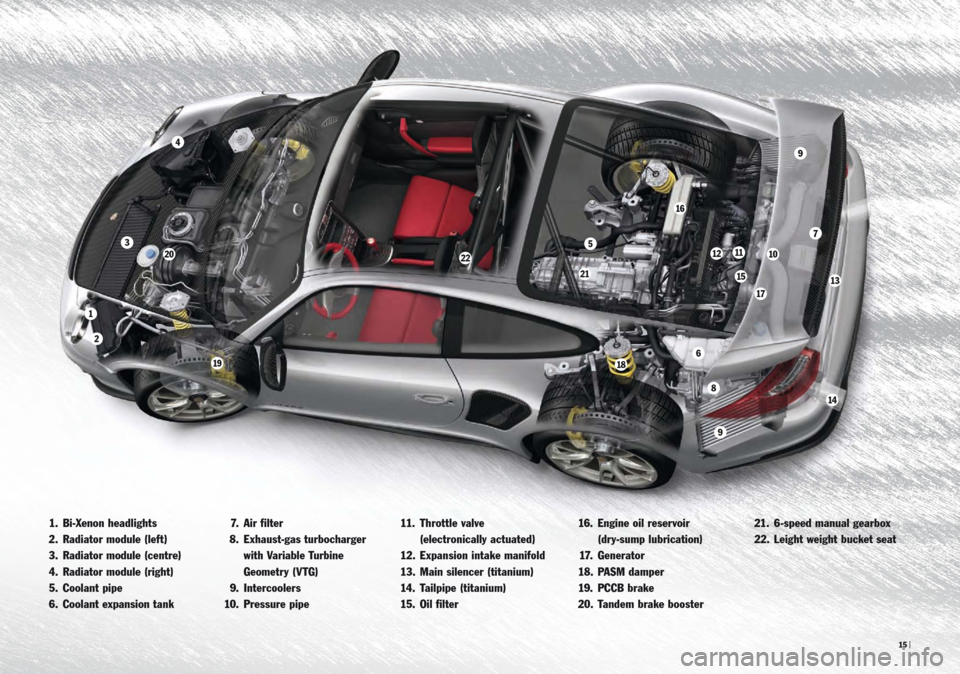
2
1
3
4
5
6
7
8
9
9
101112
13
14
15
16
17
1819
20
21
22
15 |
1. Bi-Xenon headlights
2. Radiator module (left)
3. Radiator module (centre)
4. Radiator module (right)
5. Coolant pipe
6. Coolant expansion tank 7. Air filter
8. Exhaust-gas turbocharger
with Variable Turbine
Geometry (VTG)
9. Intercoolers
10. Pressure pipe 11. Throttle valve
(electronically actuated)
12. Expansion intake manifold
13. Main silencer (titanium)
14. Tailpipe (titanium)
15. Oil filter 16. Engine oil reservoir
(dry-sump lubrication)
17. Generator
18. PASM damper
19. PCCB brake
20. Tandem brake booster 21. 6-speed manual gearbox
22. Leight weight bucket seat
Page 15 of 35
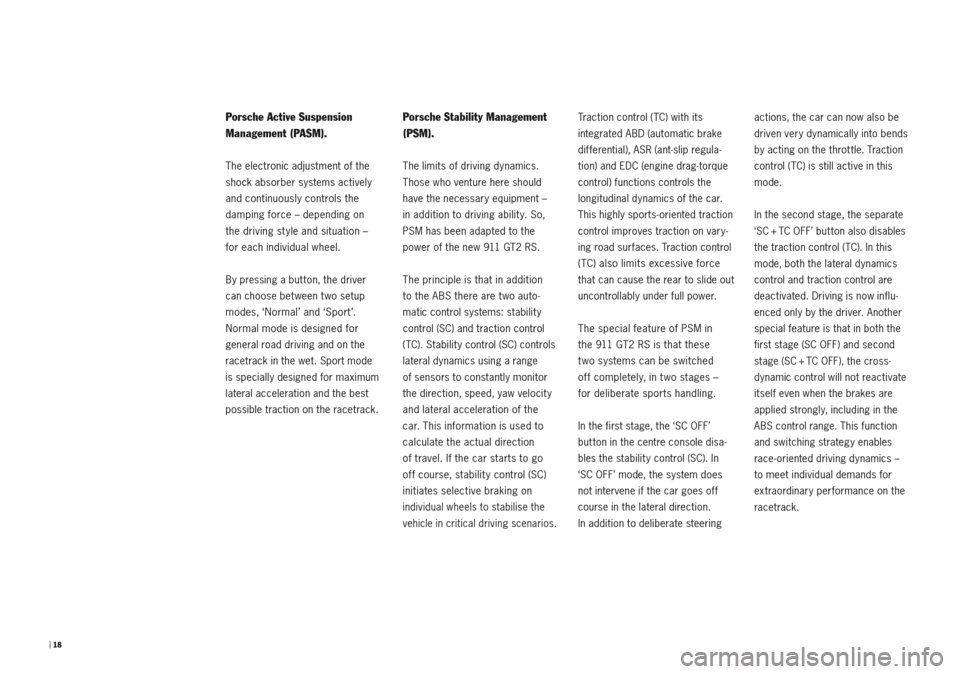
| 18
Porsche Active Suspension
Management (PASM).
The electronic adjustment of the
shock absorber systems actively
and continuously controls the
damping force – depending on
the driving style and situation –
for each individual wheel.
By pressing a button, the driver
can choose between two setup
modes, ‘Normal’ and ‘Sport ’.
Normal mode is designed for
general road driving and on the
racetrack in the wet. Sport mode
is specially designed for maximum
lateral acceleration and the best
possible traction on the racetrack.
Porsche Stability Management
(PSM).
The limits of driving dynamics.
Those who venture here should
have the necessary equipment –
in addition to driving ability. So,
PSM has been adapted to the
power of the new 911 GT2 RS.
The principle is that in addition
to the ABS there are
two auto-
matic control systems: stability
control (SC) and traction control
(TC). Stability control (SC) controls
lateral dynamics using a range
of sensors to constantly monitor
the direction, speed, yaw velocity
and lateral acceleration of the
car. This information is used to
calculate the actual direction
of travel. If the car starts to go
off course, stability control (SC)
initiates selective braking on
individual wheels to stabilise the
vehicle in critical driving scenarios.
Traction control (TC) with its
integrated ABD (automatic brake
differential), ASR (ant-slip regula-
tion) and EDC (engine drag-torque
control) functions controls the
l ongitudinal dynamics of the car.
This highly sports-oriented traction
control improves traction on vary-
ing road surfaces. Traction control
(TC) also limits excessive force
that can cause the rear to slide out
uncontrollably under full power.
The special feature of PSM in
the 911 GT2 RS is that these
two systems can be switched
of f completely, in t wo stages –
for deliberate sports handling.
In the first stage, the ‘SC OFF’
button in the centre console disa-
bles the stability control (SC). In
‘SC OFF’ mode, the system does
not intervene if the car goes off
course in the lateral direction.
In addition to deliberate steering actions, the car can now also be
driven very dynamically into bends
by acting on the throttle. Traction
control (TC) is still active in this
mode.
In the second stage, the separate
‘SC + TC OFF’ button also disables
the traction control (TC). In this
mode, both the lateral dynamics
control and traction control are
deactivated. Driving is now influ-
enced only by the driver. Another
special feature is that in both the
first stage (SC OFF) and second
stage (SC + TC OFF), the cross-
dynamic control will not reactivate
itself even when the brakes are
applied strongly, including in the
ABS control range. This function
and switching strategy enables
race-oriented driving dynamics –
to meet individual demands for
extraordinary performance on the
racetrack.
Page 31 of 35
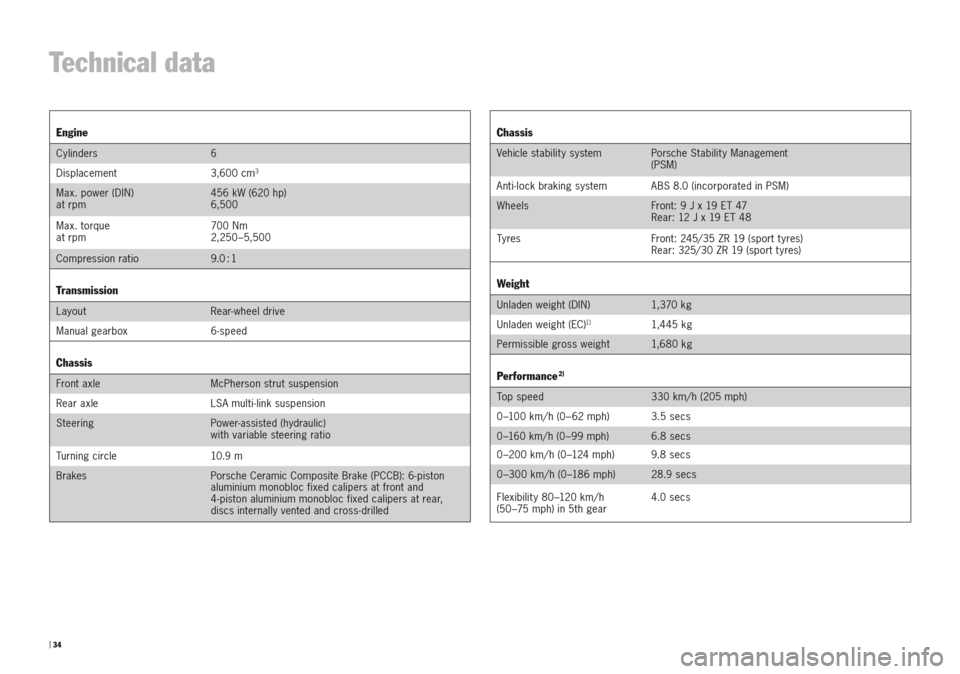
| 34
Technical data
Engine
Cylinders 6
Displacement 3,600 cm
3
Max. power (DIN)
at rpm 456 kW (620 hp)
6,500
Max. torque
at rpm 700 Nm
2,250 –5,500
Compression ratio 9.0 : 1
Transmission
Layout Rear-wheel drive
Manual gearbox 6-speed
Chassis
Front axle McPherson strut suspension
Rear axle LSA multi-link suspension
Steering Power-assisted (hydraulic)
with variable steering ratio
Turning circle 10.9 m
Brakes Porsche Ceramic Composite Brake (PCCB): 6-piston
aluminium monobloc fixed calipers at front and
4-piston aluminium monobloc fixed calipers at rear,
discs internally vented and cross-drilled
Chassis
Vehicle stability system Porsche Stability Management
(PSM)
Anti-lock braking system ABS 8.0 (incorporated in PSM)
Wheels Front: 9 J x 19 ET 47
Rear: 12 J x 19 ET 48
Tyres Front: 245/35 ZR 19 (sport t yres)
Rear: 325/30 ZR 19 (sport tyres)
Weight
Unladen weight (DIN) 1,370 kg
Unladen weight (EC)
1)1,4 45 k g
Permissible gross weight 1,680 kg
Performance2)
Top speed 330 km/ h (205 mph)
0–100 km/ h (0–62 mph) 3.5 secs
0–160 km/ h (0–99 mph) 6.8 secs
0–200 km/h (0–124 mph) 9.8 secs
0–300 km/h (0–186 mph) 28.9 secs
Flexibility 80–120 km/h
(50–75 mph) in 5th gear 4.0 secs